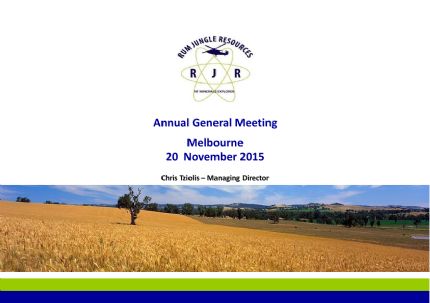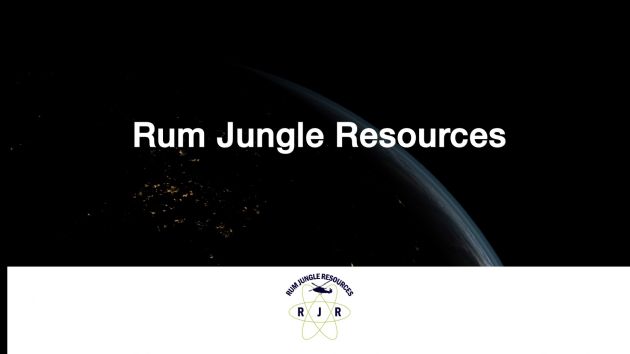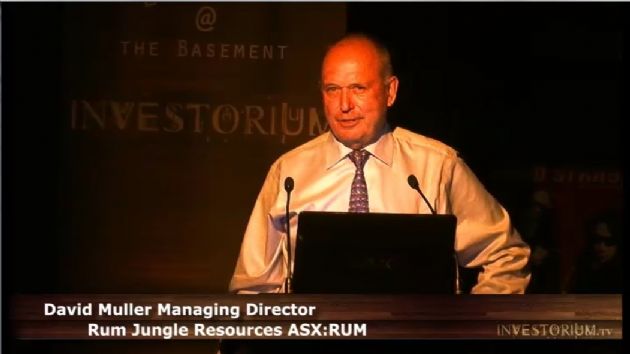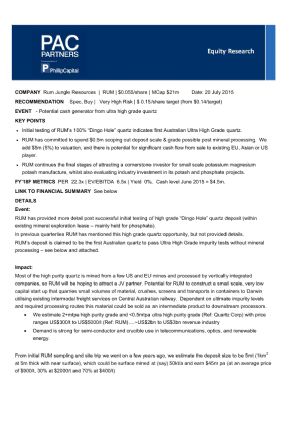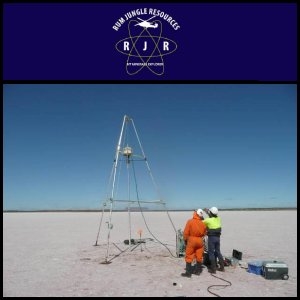 Karinga Lakes Potash Scoping Study
Karinga Lakes Potash Scoping Study
Perth, Dec 22, 2014 AEST (ABN Newswire) - Rum Jungle Resources Limited ( ASX:RUM) announce that completion of the Karinga Lakes Potash project scoping study supports the potential for future development of the Karinga Lakes potash project to produce either a sulphate of potash fertiliser or an intermediate product, a potassium magnesium sulphate fertiliser.
ASX:RUM) announce that completion of the Karinga Lakes Potash project scoping study supports the potential for future development of the Karinga Lakes potash project to produce either a sulphate of potash fertiliser or an intermediate product, a potassium magnesium sulphate fertiliser.
The Karinga Lakes project area encompasses a number of salt lakes in the southern part of the Northern Territory, approximately 200km southwest of Alice Springs. The lake system lies at eastern end of the 'Central Australian Ground Water Discharge Zone'. These lakes are located along the route of the Lasseter Highway which connects to the Stuart Highway and proximate to the Central Australian Railway, giving access to potential markets in both Asia, through Darwin and southern Australia.
The knowledge gained through the scoping study process, specifically regarding the chemistry of the brines, the potential yields, the processing methodologies and the baseline economics, form a basis from which to continue work on the Karinga Lakes Project. Furthermore, this knowledge can be leveraged into shaping exploration and development strategies for the larger salt lakes in Rum Jungle Resources' portfolio, such as Lake Torrens, Lake Frome or Lake Amadeus, subject to access approvals.
This potentially enables a strategy of a small scale, limited environmental footprint and low capital start-up at the Karinga Lakes project to start developing the regional markets for these products and generating cash for the company. This initial development could then be followed by the development of a larger scale operation in the course of time.
It is also worth noting that fertilser commodities such as potash and phosphates have actually increased in price over the last 12 months since their lows in late 2013. This is in contrast to iron, ore, coal and oil. There are no substitutes for potassium (Potash) and phosphates in agriculture. Accordingly, Rum Jungle Resources' portfolio of sulphate of potash projects combined with the Ammaroo Phosphate Project positions the company to leverage growth in demand for fertilisers in the Asia-Pacific region, including Australia.
SUMMARY
Rum Jungle Resources Ltd is pleased to announce the completion of the Karinga Lakes Potash Project Scoping Study. The baseline knowledge and understanding of the chemical and physical properties of the brine resource, technical brine extraction, evaporation, mechanical processing, logistics, regional markets and pricing, now provides a basis for formal discussions with potential development and off take partners.
Partners will likely be required to fund a bankable feasibility study on an initial development of Karinga and further exploration of the other salt lakes in the portfolio. With almost all of the potassium needs of Australia, New Zealand and southern Asia met by imports, the potential evolution of a sulphate of potash industry in Australia could create significant value over time.
A review of the extractable brine resource, chemical composition and processing analytics, process flow sheet design, mass balance work and general brine extraction and processing facility layout was completed by China International Chemical Consulting Corporation (CICCC). CICCC utilised people resources that had previously been involved in the development and expansion of the Louobopo salt lake sulphate of potash operation in North Western China. GHD Australia completed scoping study level estimates of Australian capital and operating costs, based on the CICCC design. Baseline regional market studies for both sulphate of potash and potassium magnesium sulphate were also conducted.
Two development scenarios were studied to a scoping study level of accuracy (+/- 40% capital and operating costs):
Scenario 1
- 125,000 tonnes per annum of sulphate of potash (SOP) for a minimum of 10 years of production
Scenario 2
- 100,000 tonnes per annum of potassium magnesium sulphate (schoenite) for a minimum of 15 years of production.
Schoenite is an intermediate product of the sulphate of potash process. Compared to SOP, Schoenite contains approximately half the amount of K2O and is therefore a lower value product than SOP. It does however contain magnesium which potentially represents a certain level of value. The Scenario 2 project is approximately one fifth the size of scenario 1 and represents the potential to develop a small scale start up, using a smaller number of lakes thus decreasing the environmental footprint and significantly lower energy usage due to lower volumes of brines being pumped smaller distances and avoiding the need to create steam that is used to convert schoenite to SOP. However, the market for schoenite as a fertiliser is less well defined than the market for SOP.
RESOURCE POSITION
For scenario 1, 75% of the insitu potash brine resource is in the Measured and Indicated JORC (2012) categories. Brine for scenario 1 is to be sourced from 25 salt lakes with a total insitu brine resource of 8.36 million tonnes K2SO4. This resource is JORC (2012) compliant and was released to the ASX on 20 February 2014 and has not changed since. This resource incorporates only insitu potash brines and does not include any potential deeper, ground water sources of potash brines that may exist and recharge that may be present in the system.
For scenario 2, 93% of the insitu potash brine resource is in the Measured and Indicated JORC (2012) resource categories. Brine for Scenario 2 is to be sourced from 14 salt lakes with a total brine potash resource of 4.5 million tonnes K2SO4.
It should be noted that brine recovery rates are determined by the drainable porosity of the system; that is the rate at which brines can be extracted as determined by their ability to flow through the rock structures. This determines how much of the resource can be extracted over a given period of time. This limits the amount of the insitu resource that can theoretically be extracted. However, this recovery factor could be influenced by ground water recharge, as it is believed the lakes are controlled by fracture zones, as well as rainfall recharge that could significantly increase the amount of recoverable K2O to underpin the project and perhaps even provide volume upside. Recharge rates remain uncertain.
In the case of scenario 1, without reasonable ground water and rainwater recharge, it may be difficult to extract sufficient brines from the system to achieve 125,000 tonnes per annum of SOP production for a minimum of 10 years. Another method of mitigating risk around resource recovery rates is through further exploration and the identification of deeper brine aquifers under the lakes that can be added to the resource and increase the recovery rates of the brines. If these deeper brine aquifers are present, a larger scale SOP production facility may be possible and bring to bear better economies of scale.
For scenario 2, it is considered that there are sufficient recoverable brines in the known insitu resource and without recharge to support the 15 year operation envisaged.
To view the full release, please visit:
http://media.abnnewswire.net/media/en/docs/ASX-RUM-417150.pdf
About Verdant Minerals Ltd
 Verdant Minerals Ltd's (ASX:VRM) strategic intent is to create shareholder value through the discovery, development and operation of fertiliser and industrial mineral projects, located in close proximity to existing transport infrastructure, with a primary focus on the Northern Territory of Australia.
Verdant Minerals Ltd's (ASX:VRM) strategic intent is to create shareholder value through the discovery, development and operation of fertiliser and industrial mineral projects, located in close proximity to existing transport infrastructure, with a primary focus on the Northern Territory of Australia.
![abnnewswire.com]()
Related Companies
Social Media
Share this Article

 ASX:RUM) announce that completion of the Karinga Lakes Potash project scoping study supports the potential for future development of the Karinga Lakes potash project to produce either a sulphate of potash fertiliser or an intermediate product, a potassium magnesium sulphate fertiliser.
ASX:RUM) announce that completion of the Karinga Lakes Potash project scoping study supports the potential for future development of the Karinga Lakes potash project to produce either a sulphate of potash fertiliser or an intermediate product, a potassium magnesium sulphate fertiliser. Verdant Minerals Ltd's (ASX:VRM) strategic intent is to create shareholder value through the discovery, development and operation of fertiliser and industrial mineral projects, located in close proximity to existing transport infrastructure, with a primary focus on the Northern Territory of Australia.
Verdant Minerals Ltd's (ASX:VRM) strategic intent is to create shareholder value through the discovery, development and operation of fertiliser and industrial mineral projects, located in close proximity to existing transport infrastructure, with a primary focus on the Northern Territory of Australia.



